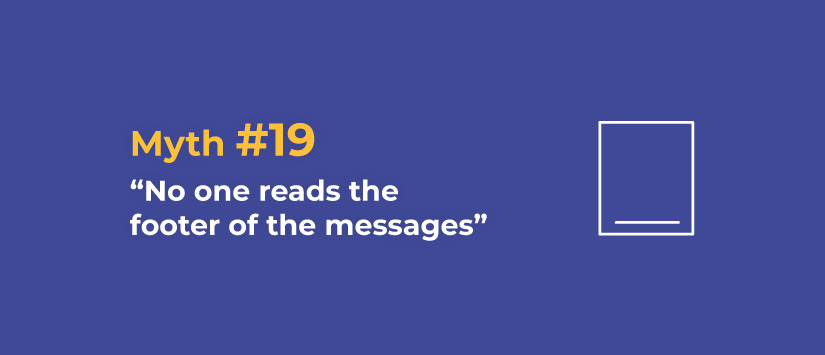Category: Email Marketing

The only way to know if someone reads any part of an email message is if they click on a link. Since Mail Privacy Protection, even openings do not indicate that the subject line is read. By looking at how many people update their details or unsubscribe, you will know how many have read the footer. Also, if you include some kind of call to action, you will be able to check this. So, even if it is not the most read, it is a myth that nobody pays attention to the footer because it does include relevant information for the user.
The main reason to have a footer in your emails is that you legally have to provide the user with certain information in each email and this is the most appropriate place so that it does not stand out too much or blend in with the body of the message. If you think of the footer as the small print of a contract, you will only see it as an appendix written by lawyers that is not worth paying attention to. But it is much more.
The footer serves to give subscribers confidence because they can find out which company is behind the mailing and how it treats their personal data, for example if it is shared with third parties. If you do not show the possibility of unsubscribing from the mailings, the user would not trust the sender and would hardly be interested in buying your products or services.
The footer is just one more element in the email marketing campaign, so it is important to take care of both the wording and the visual aspect. It helps to consolidate the brand identity, for example with personalised texts and colours or by reinforcing key messages, such as the slogan or the logo. In this sense, it deserves the same attention as the header because, if this serves to open the message, the footer closes it, so they must be at the same level.
Perhaps it is the legal content that gives the footer the reputation of being a block that is rarely read or noticed, but it should still be included. In fact, it is mandatory to provide the following information:
As they cannot be hidden in order not to mislead the user and to respect the law, these texts are usually banished to the bottom of the page where they are not the protagonist. This can also include all the information that is repeated in each mailing and that does not fit into a commercial promotion, such as:
The footer usually occupies a small space compared to the rest of the message, but it should be considered as important as the other elements.
The footer can follow the same style as the rest of the campaign, but you can also add a more informal touch to draw attention to the mandatory messages. For example: "We are sorry you want to stop receiving our newsletter, but we respect your decision" or "Have you changed jobs? Update your details before your boss deletes your email address".
Including the reason why they are receiving our email is not mandatory, but it is good practice. The most common reasons are because they filled in a newsletter form, registered for an event or shopped on the website. To make it different, it could be for example: "Are you wondering why you received this message? Because you signed up on our newly launched website to receive our exclusive discounts - how could you forget!
You don't have to ask them to add us to their address book either, although it may be in your interest to avoid being considered as spam. For example: "We don't want you to miss out on any of our promotions, if you don't want to miss out: add us to your contacts".
For the footer to be read, it can be written as if it were a personal letter, adding personalised sentences as in the header. For example: "PS. We want to know your opinion, [Name]: answer this survey to tell us what you thought of this newsletter".
When the footer goes underneath the farewell or signature, you can keep the same visual style to give continuity to the message. But in promotional campaigns, it is more interesting to separate it graphically, for example with a line or a change of colours. However, always taking care of the contrast so that both the text and the links can be read well.
Following this same objective, you should avoid making the font too small and with little separation between paragraphs. It is well known that the longer the message, the worse it is to read, but precisely to make it easier to read, the typography should also be taken care of on mobile devices.
The footer should be kept clean, simple, but always up to date. It can be used to highlight information for a period of time, such as a change in the timetable or a new telephone number in the office. It is therefore advisable to mark in the calendar the date on which this type of data should be removed so that this does not happen.
Within the footer hierarchy, if you want to add a lot of information, it is possible to include a menu with buttons or highlighted sections of the online shop, although it should be simplified so as not to overload the design, as happens on the web.
One last note: to maintain consistency throughout all submissions, remember that you can lock the footer in your template and thus also avoid errors.
Do not miss anything from our blog and join our Telegram https://t.me/acrelianews
Haven't you tried Acrelia News yet?
If you like this post, you will like much more our email marketing tool: professional, easy to use.